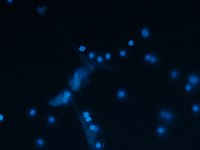
Photo from wikipedia
Polychlorinated biphenyls (PCBs) are a group of persistent organic environmental pollutants with various toxic effects. Our previous research found that a highly reactive quinone metabolite of PCBs, namely, PCB29-pQ, causes… Click to show full abstract
Polychlorinated biphenyls (PCBs) are a group of persistent organic environmental pollutants with various toxic effects. Our previous research found that a highly reactive quinone metabolite of PCBs, namely, PCB29-pQ, causes excessive reactive oxygen species (ROS) production and different toxic actions. Neutrophil extracellular traps (NETs), the product of NETosis, are one of the newly discovered programmed cell deaths. Recent studies have suggested the association of NET formation with excess ROS. The objective of this study was to investigate the influence of PCB29-pQ exposure on NETs and its possible molecular mechanisms. Using scanning electron microscopy, immunofluorescence microscopy, and the quantitative analysis of extracellular DNA, we found that PCB29-pQ exposure induces the formation of NETs in mouse bone marrow. Mechanistically, our results suggested that PCB29-pQ induces histone citrullination and chromatin decondensation, which are necessary processes for NET formation. Moreover, PCB29-pQ exposure increases ROS and autophagy levels, while ROS and autophagy inhibitors significantly reverse NET formation. These results indicated that PCB29-pQ-induced NET formation was mediated by the intracellular ROS level and autophagy signaling. In general, our research uncovered a toxicity mechanism of PCB29-pQ, which suggested the necessity of evaluating its immunotoxicity during the risk assessment of PCB exposure.
Journal Title: Chemical research in toxicology
Year Published: 2022
Link to full text (if available)
Share on Social Media: Sign Up to like & get
recommendations!